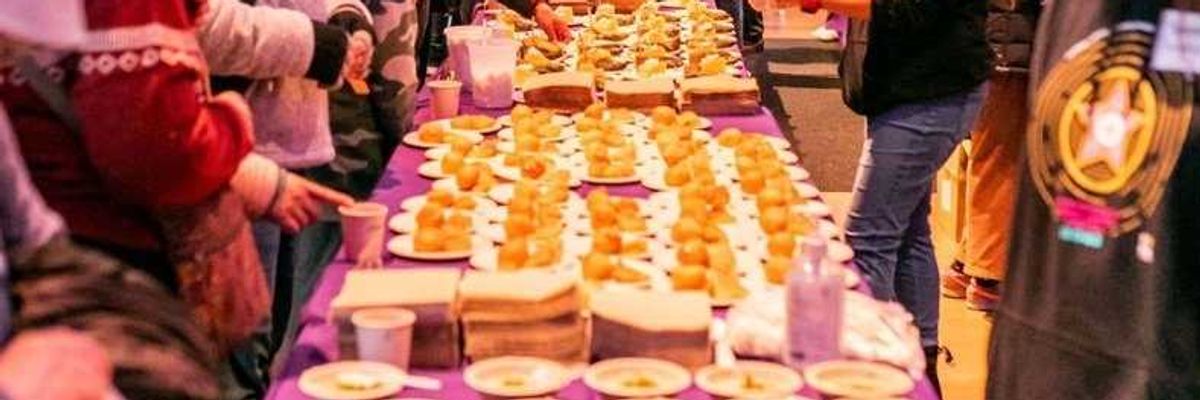For the socially conscious eater caught between vegan quinoa wraps and pigs’ heads, where is the sweet spot?
I used to find vegans irritating. As a cook and food writer, I couldn’t relate to people who put politics before the pure joy of experiencing food in all its complexity; I felt no shame piling grilled chicken on top of a leafy summer salad, braising beef shanks for a wintertime party and baking up desserts loaded with cream and eggs. But, like so many San Franciscans, my relationship to meat and dairy changed over a decade of digesting Michael Pollan and Eric Schlosser’s writings and watching films like Food, Inc.
For a while, I became one of those smug, show-offy, cow-share types, and our family meals began to feature pasta Bolognese made with Morris grass-fed beef. Then last year, some friends and I upped the ante and bought half of a hog from a small farmer in Manteca who specializes in heritage breeds. Feeling like a latecomer to the pork-parts thing, I would do my due diligence and take the head (well, half the head).
But what to do with it? I talked myself out of making head cheese due to the time commitment. In all honesty, I got scared every time I looked at the Cryovac bag snugly wrapped around the hog’s face, with its doe-eyed smile. It stayed in our freezer for many months after we’d eaten the ribs and belly and turned the bones to stock. Finally I came across a recipe for pork-head pozole, which was more in my comfort zone. Hoping to avoid a traumatic encounter between my kids and the pig, I set aside a school day to cook it.
But as it simmered in my stockpot, the snout kept bobbing up to the surface, sweet and plaintive. When it was almost done, I noticed that the slow cooking had gradually forced the mouth open, revealing human-looking teeth. The pozole was delicious, but I was deeply shaken. The intimacy of pulling flesh from an animal’s face stays with you.
A month or so later, I got a newspaper assignment to write an article about the rise of veganism in San Francisco. Underground vegan bake sales were hopping, and new vegan restaurants like Gracias Madre in the Mission District were opening. I went from enjoying my whole-hog dinners to collecting alarming statistics about meat (such as the fact that a pound of corn-fed beef requires 12,000 gallons of water to produce, compared to 60 gallons of water for a pound of potatoes).
I headed to the Saturday Ferry Plaza Farmers Market to look for baby turnips and three kinds of heirloom carrots to test the recipes accompanying the story. For lunch, I picked up a raw vegan wrap from Alive!. Turning the bend, chewing loudly (uncooked quinoa is very crunchy), I had a new awareness of the carnivorous orgy around me. Everywhere I looked, people were hoisting plates loaded with a 4505 Meats extravaganza here, a Prather Ranch protein fix there. Their clearly satisfied grins said it all: “I am making good choices. My meat costs a lot of money, so it must be OK!”
Suddenly, I could relate to the foie gras protesters. Who were these barbarians with their fancy chunks of flesh? I went home and tested the complex, surprisingly great vegan dishes, feeling virtuous.
It was a brief bout of vegan-righteousness, and as usual, things weren’t as black and white as I thought. When I asked Eric Tucker, the chef of San Francisco’s high-end vegan restaurant, Millennium, what he thought was fueling the vegan trend, his answer took me by surprise. Many of his former line cooks, once die-hard vegans, had gotten into head-to-tail animal cooking after they left the restaurant. Instead of working with five kinds of seaweed, they were spending their days scooping brains out of skulls and pickling tongues.
“Pork is the new vegan. I’m dead serious,” he told me. We agreed that the availability of sustainably raised animals and the trend toward using the whole animal in a responsible manner has given a lot more people license to consume meat.
Eric made me realize that although both veganism and the whole-animal, extreme meat-eating trend inhabit the fringes of the American dietary spectrum, they share a common political goal—one of using food resources wisely and with a conscience. Just as the availability of grass-fed beef has brought many vegetarians back to the steak-eating fold, a new generation of carnivores is flocking to places like Loving Hut in the Westfield Centre for vegan fast food. Clearly these two movements are starting to find common ground.
As for me, dabbling in both camps left me realizing that I’ll probably have to be OK with inhabiting that blurry place in the middle. I will keep trying to substitute more vegetables and grains for meat and cheese, and when it’s meat, I’ll make it sustainable—except for the occasional carnitas taco from a truck.
At the same time, I’ve become a little braver about facing up to the animals I do eat. My brother and sister-in-law—another former vegetarian—tend egg-laying chickens at their off-the-grid, organic farm in Mendocino. They’re raising meat chickens for the first time and recently asked me to help “harvest” the white leghorns in a few months. I’m not saying I’m excited about it, but I’m up for any revelation the experience might provide. In this city, where the contents of your refrigerator are fraught with political meaning, just the act of eating comes with a level of moral anxiety. We have no choice but to live with it.
Now how are we going to cook that chicken?
Tara Duggan is a food writer and cookbook author who lives in Glen Park. She writes the “Working Cook” column for the San Francisco Chronicle.



















